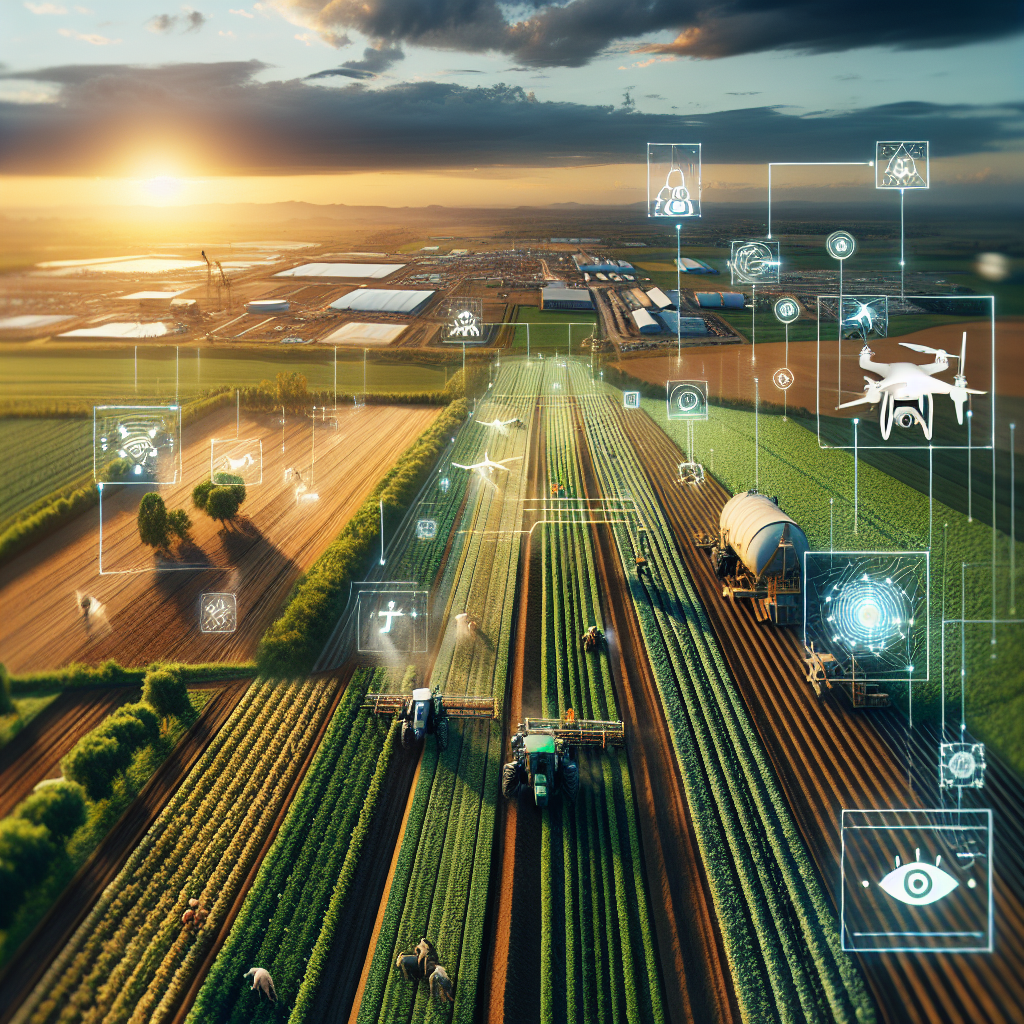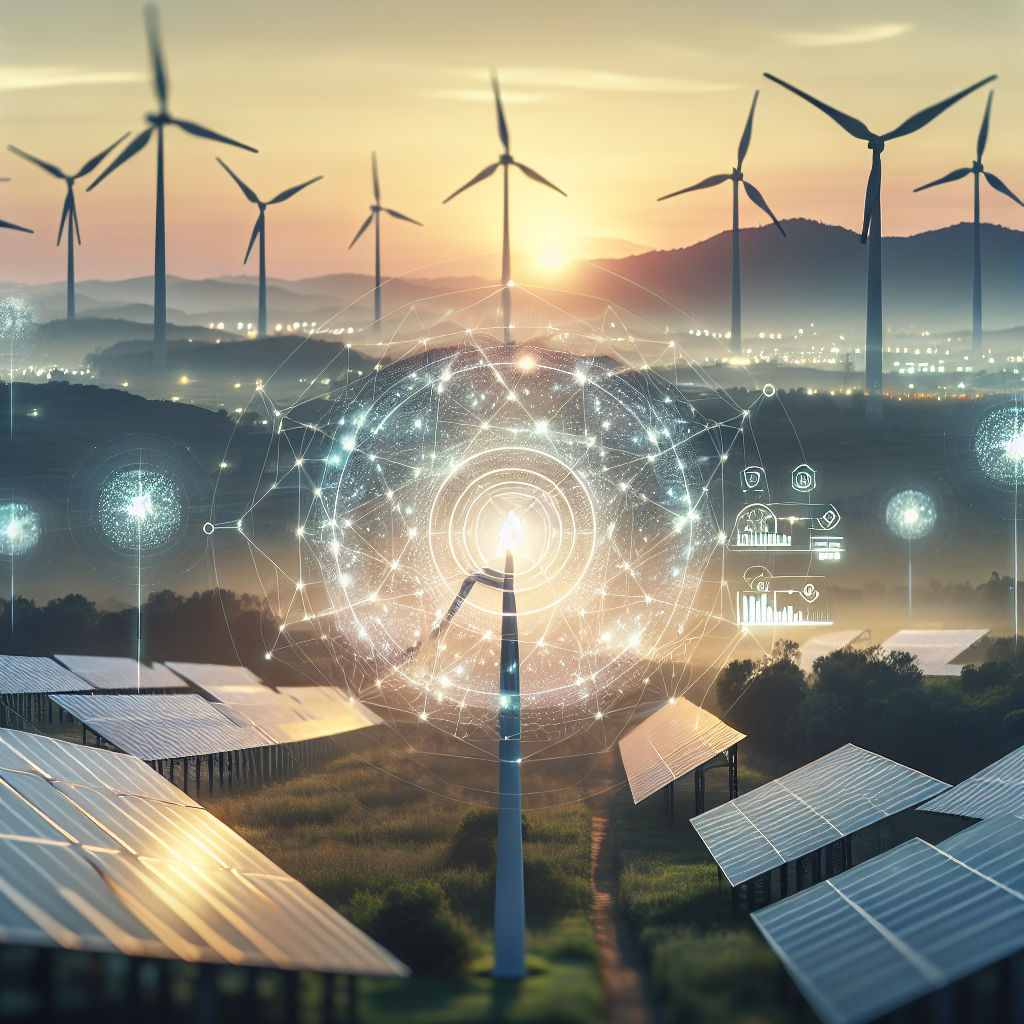The Role of AI in Modern Agriculture
Artificial Intelligence (AI) has become a cornerstone in the evolution of modern agriculture, offering innovative solutions that address both efficiency and sustainability. By integrating AI technologies, farms can optimize resource usage, predict environmental impacts, and improve crop yields. This not only reduces waste but also ensures that food production can meet the demands of a growing global population. AI systems can analyze vast amounts of data from various sources, providing actionable insights for farmers. These insights help in making informed decisions regarding planting, irrigation, and harvesting, ultimately leading to a more sustainable agricultural practice.
AI in Precision Farming: Precision farming is one of the most significant areas where AI is making a substantial impact. By using AI-powered drones and sensors, farmers can monitor crop health, soil conditions, and weather patterns in real-time. This technology enables the application of water, fertilizers, and pesticides with pinpoint accuracy, reducing the amount needed and minimizing environmental impact. For instance, AI algorithms can predict the best times for planting and harvesting, ensuring optimal growth conditions and reducing crop loss.
AI-Powered Predictive Analytics: Another critical application of AI in agriculture is predictive analytics, which leverages historical data and real-time inputs to forecast future agricultural trends. This allows farmers to anticipate challenges such as pest infestations or adverse weather conditions and take preemptive actions. AI can also help in optimizing supply chains, ensuring that products reach markets in a timely manner, thereby reducing food waste. By predicting demand more accurately, AI helps in balancing supply with consumer needs, enhancing overall food security.
The adoption of AI in agriculture is further illustrated through the following use cases:
- Automated machinery for planting and harvesting, reducing labor costs and time.
- AI systems for monitoring livestock health, ensuring better quality produce.
- Smart irrigation systems that adjust water delivery based on real-time data, conserving water resources.
In summary, AI is revolutionizing agriculture by introducing smart, data-driven approaches that enhance productivity and sustainability. The integration of AI technologies not only supports environmental conservation but also improves the economic viability of farming operations, paving the way for a more resilient food system.
AI-Powered Food Waste Reduction
Artificial Intelligence (AI) is revolutionizing the way we approach food waste reduction, a critical issue in achieving a sustainable food system. By integrating AI technologies, businesses and organizations can significantly cut down on waste throughout the supply chain. One primary application of AI is in demand forecasting, where algorithms analyze historical sales data, weather patterns, and local events to predict future demand with high accuracy. This ensures that food producers and retailers stock the right amount of products, reducing the likelihood of overproduction and spoilage.
AI is also pivotal in optimizing inventory management. By utilizing machine learning algorithms, businesses can monitor the shelf life of perishable goods in real time. These systems can alert retailers when products are nearing expiration, allowing them to implement strategies such as dynamic pricing or targeted promotions to encourage quick sales. Moreover, AI-powered image recognition technologies can enhance sorting processes in food production facilities, distinguishing between edible and inedible items to minimize waste.
The impact of AI on food waste reduction is further exemplified in its application within smart packaging solutions. AI-enabled sensors in packaging can monitor the freshness of food and provide real-time data to both consumers and retailers. This technology not only helps to extend the shelf life of products but also empowers consumers to make informed decisions, thereby reducing household food waste. Additionally, AI-driven platforms can connect surplus food with charities and food banks, ensuring excess food reaches those in need rather than ending up in landfills.
To illustrate the effectiveness of AI in reducing food waste, consider the following data visualization:
| Year | Food Waste Reduction (%) |
|---|---|
| 2020 | 10% |
| 2021 | 15% |
| 2022 | 20% |
These figures demonstrate the growing impact of AI technologies in mitigating food waste over recent years, highlighting its potential as a powerful tool for sustainable food management.
Optimizing Supply Chains with AI
Artificial Intelligence (AI) is revolutionizing supply chains in the food industry by enhancing efficiency and sustainability. One of the main challenges in traditional supply chains is the mismatch between supply and demand, which often leads to food waste. AI addresses this issue by using predictive analytics to forecast demand more accurately. These predictions help retailers and suppliers adjust their inventory levels, reducing surplus and minimizing waste.
AI systems collect and analyze vast amounts of data from various sources such as weather patterns, consumer purchasing behavior, and market trends. By processing this data, AI can identify patterns and provide actionable insights. This capability allows businesses to make informed decisions, such as when to harvest crops or how to allocate resources efficiently. For example, AI-driven platforms can suggest the most efficient transportation routes, reducing fuel consumption and emissions.
Furthermore, AI enhances transparency and traceability in the supply chain. By utilizing technologies like blockchain, AI ensures that all stakeholders have access to real-time data regarding the origin, handling, and quality of food products. This transparency builds consumer trust and helps in the quick identification and resolution of any issues that may arise, such as contamination or spoilage.
Below is a summary table illustrating the impact of AI on supply chain optimization:
| AI Application | Benefit | Impact |
|---|---|---|
| Predictive Analytics | Accurate Demand Forecasting | Reduced Waste |
| Route Optimization | Efficient Transportation | Lower Emissions |
| Blockchain Transparency | Traceability | Increased Consumer Trust |
AI and Sustainable Urban Farming
Artificial Intelligence (AI) is revolutionizing the concept of urban farming, creating smarter and more efficient methods to produce food sustainably within city environments. By harnessing the power of AI, urban farms can enhance their productivity and reduce resource consumption, making fresh produce more accessible to urban populations.
AI technologies are instrumental in optimizing various aspects of urban farming, from crop monitoring to resource management. AI-powered sensors and cameras can monitor plant health in real-time, detecting issues such as pest infestations or nutrient deficiencies early. This allows for timely interventions that minimize crop loss and waste. Furthermore, AI algorithms can analyze data to predict optimal harvest times, ensuring that produce is picked at peak freshness and flavor.
Urban farming also benefits from AI in terms of resource efficiency. AI systems can optimize water and energy usage, making urban farms more sustainable. For instance, AI can predict weather patterns, allowing farms to adjust their water usage accordingly, conserving water during rainy periods and optimizing irrigation during dry spells. Below is a simple example of how AI improves resource management:
| Resource | Traditional Usage | AI-Optimized Usage |
|---|---|---|
| Water | 100% | 70% |
| Energy | 100% | 60% |
Additionally, AI facilitates the integration of vertical farming and hydroponics into urban settings. These methods can be managed precisely with AI, maximizing yield in limited spaces. By using AI to simulate different growing conditions, urban farms can identify the most efficient setups for various crops, ensuring a higher yield while using fewer resources. This not only makes urban farms more viable but also helps in reducing the carbon footprint associated with transporting food from rural areas to urban centers.
Precision Agriculture for Resource Efficiency
Precision agriculture is at the forefront of enhancing resource efficiency in sustainable food production. By leveraging AI technologies, farmers can optimize the use of inputs such as water, fertilizers, and pesticides, thereby minimizing waste and reducing environmental impact. AI systems analyze vast amounts of data from sensors and satellite imagery to provide real-time insights into crop health and soil conditions. This allows farmers to make informed decisions, ensuring that resources are used only where and when they are needed.
The impact of AI in precision agriculture is profound, as it assists in maximizing yield and minimizing resource consumption. For instance, AI-driven irrigation systems can determine the precise amount of water required for different sections of a field, reducing water wastage significantly. Moreover, AI algorithms can predict pest infestations, enabling targeted pest control measures that limit the use of harmful chemicals.
To understand the benefits of precision agriculture using AI, consider the following key advantages:
- Improved crop yields through optimized planting schedules and resource allocation.
- Reduction in chemical inputs, leading to cost savings and improved environmental health.
- Enhanced soil health monitoring, promoting sustainable farming practices.
- Real-time data analysis for quick decision-making and response to changing conditions.
The integration of AI in precision agriculture is illustrated in the following data visualization:
| Resource | Traditional Usage | AI-Optimized Usage | Reduction (%) |
|---|---|---|---|
| Water | 1000 liters/acre | 700 liters/acre | 30% |
| Fertilizers | 200 kg/acre | 150 kg/acre | 25% |
| Pesticides | 50 kg/acre | 30 kg/acre | 40% |
AI in Food Distribution and Access
Artificial Intelligence (AI) is revolutionizing food distribution systems, making them more efficient and equitable. By analyzing vast amounts of data, AI can identify patterns and optimize routes, ensuring that food reaches its destination faster and with minimal waste. This technological innovation is particularly beneficial in reducing the carbon footprint of food distribution networks. Furthermore, AI-driven platforms can predict demand more accurately, helping to balance supply with customer needs and reduce instances of overproduction.
One significant advantage of AI in this sector is its ability to enhance access to food for underserved communities. AI can analyze socioeconomic data to identify areas with limited access to fresh produce and essential food items. By doing so, it encourages the development of targeted distribution strategies that prioritize these “food deserts.” Additionally, AI-powered applications can connect local food banks with surplus food from retailers and restaurants, ensuring that excess food is redirected to those in need rather than going to waste.
The integration of AI in food distribution is not just about cutting costs; it’s also about creating a more sustainable and just food system. For instance, AI can optimize last-mile delivery by using real-time traffic data, which ensures timely deliveries and reduces fuel consumption. This efficiency is crucial for maintaining the freshness of perishable goods. Moreover, AI-driven inventory management systems help prevent overstocking and understocking, which are common problems that lead to food spoilage and loss.
| AI Application | Impact |
|---|---|
| Route Optimization | Reduces transportation time and emissions |
| Demand Prediction | Balances supply with consumer needs |
| Access Enhancement | Improves food availability in underserved areas |
Smart Packaging and Shelf-Life Prediction
Smart packaging is revolutionizing the way we interact with food products, playing a crucial role in reducing waste and ensuring food safety. By incorporating sensors and indicators, smart packaging can monitor the condition of the food, providing real-time updates on freshness and quality. This technology helps both retailers and consumers make informed decisions about the usability of food products, significantly reducing the amount of food that is prematurely discarded due to uncertainty about its freshness.
One of the key features of smart packaging is its ability to predict shelf-life accurately. Through the integration of AI algorithms, these packaging systems can analyze data such as temperature, humidity, and light exposure to estimate the remaining shelf-life of a product. This predictive capability allows for better inventory management, as retailers can rotate stock based on actual freshness rather than relying solely on expiration dates. Additionally, consumers benefit from a clearer understanding of how long they can safely keep products, contributing to reduced household food waste.
The implementation of smart packaging solutions has shown promising results in various sectors of the food industry. A recent study highlighted in the table below demonstrates the impact of smart packaging on waste reduction:
| Industry Sector | Waste Reduction (%) | Improved Shelf-Life (%) |
|---|---|---|
| Retail | 20 | 15 |
| Food Service | 25 | 18 |
| Household | 30 | 20 |
The above data illustrates how different sectors benefit from smart packaging innovations, showcasing a substantial reduction in waste and an extension in product shelf-life. As AI technology continues to evolve, we can expect even more sophisticated solutions that further enhance the sustainability of our food systems.
AI-Driven Consumer Behavior Analysis
AI-driven consumer behavior analysis is revolutionizing the way we understand and interact with food consumption patterns. By utilizing vast amounts of data, AI systems can identify trends and preferences that were previously unnoticed. This allows businesses to tailor their offerings to meet consumer demands more accurately, ultimately reducing waste. For instance, AI can analyze purchasing data to predict which products are likely to be in higher demand during specific periods, thereby optimizing inventory levels and minimizing spoilage.
An important application of AI in consumer behavior analysis is in personalized nutrition. By analyzing individual dietary habits and preferences, AI can offer personalized recommendations that encourage healthier eating patterns. This not only enhances consumer satisfaction but also promotes sustainable consumption practices. Additionally, AI systems can monitor social media and online reviews to gauge consumer sentiments, providing valuable insights into public perception and potential areas for product improvement.
Moreover, AI technology helps retailers design more efficient marketing strategies. By understanding consumer behavior at a granular level, companies can craft targeted campaigns that resonate with specific demographics. This targeted approach reduces unnecessary production and marketing expenses, contributing to overall sustainability. Below is a basic representation of how AI categorizes consumer behavior patterns:
| Behavior Pattern | AI Application | Impact |
|---|---|---|
| Purchase Frequency | Inventory Management | Reduces Overstock |
| Product Preferences | Personalized Recommendations | Increases Consumer Satisfaction |
| Sentiment Analysis | Feedback Collection | Enhances Product Development |
In conclusion, the integration of AI in analyzing consumer behavior not only facilitates more sustainable food production and distribution but also empowers consumers to make informed choices. This symbiotic relationship between AI and consumer insights is a promising avenue for achieving long-term sustainability in the food sector.
AI in Climate-Resilient Crop Development
The integration of artificial intelligence in agriculture is paving the way for the development of climate-resilient crops. As climate change poses a significant threat to global food security, AI technologies are being harnessed to enhance the adaptability of crops to changing environmental conditions. AI algorithms analyze vast datasets, including weather patterns, soil conditions, and crop genetics, to predict how plants will respond to various stressors such as drought, heat, and pests. This predictive capability enables researchers and farmers to focus on breeding and cultivating crops that can withstand extreme conditions, ensuring a stable food supply.
One of the primary applications of AI in this field is the use of machine learning models to simulate crop growth under different climate scenarios. These models help in identifying the traits that contribute to resilience and in understanding the genetic markers associated with these traits. For instance, AI can pinpoint specific genes that make certain crop varieties more drought-tolerant. By leveraging this information, plant breeders can develop new varieties that are better suited to withstand climate challenges.
Moreover, AI-driven tools are enhancing precision agriculture practices, which are crucial in developing resilient crops. Farmers utilize AI-powered sensors and drones to monitor crop health and soil moisture levels in real-time. The data collected is analyzed to provide actionable insights on optimal irrigation schedules and pest control measures. Such precision not only improves crop yield but also minimizes resource wastage, contributing to sustainable farming practices.
To illustrate the impact of AI in this domain, consider the following table showcasing data on crop yield improvements due to AI interventions:
| Crop Type | Yield Increase (%) | AI Technique Used |
|---|---|---|
| Wheat | 15 | Predictive Modeling |
| Corn | 20 | Genetic Analysis |
| Rice | 18 | Precision Irrigation |
Ethical Considerations in AI Food Systems
The integration of AI in food systems brings forth a plethora of ethical considerations that must be meticulously addressed. One of the key issues is data privacy. As AI technologies rely heavily on data to optimize and predict food supply chain operations, the collection and use of such data can lead to potential breaches of privacy. Ensuring that data is collected with consent and used responsibly is paramount to maintaining trust among stakeholders. Additionally, transparency in AI algorithms is crucial. Stakeholders must understand how AI decisions are made, especially when they affect food distribution and access.
Beyond privacy, equity and access are significant ethical concerns. AI has the potential to bridge the gap in food accessibility, yet there is a risk of exacerbating existing inequalities if not implemented thoughtfully. For example, small-scale farmers may struggle to access AI technologies due to cost or lack of technical expertise, leading to a widened gap between large agribusinesses and smaller producers. To address this, initiatives must be put in place to ensure equitable access to AI advancements, such as subsidizing costs or providing training programs.
Moreover, the impact on employment cannot be overlooked. While AI can streamline operations and increase efficiency, it may also lead to job displacement in certain sectors of the food industry. It is essential to balance technological advancement with human employment by creating new roles in AI development and maintenance, as well as offering retraining opportunities for affected workers. A collaborative approach between policymakers, companies, and educational institutions can help mitigate the negative impacts of AI on the workforce.
Finally, the ethical use of AI in food systems also involves environmental considerations. AI can significantly reduce food waste through predictive analytics and precision farming, but these benefits must be weighed against the environmental costs of developing and maintaining AI infrastructure, such as energy consumption and electronic waste. A sustainable approach requires ongoing assessment and improvement of AI technologies to ensure that their environmental footprint is minimized while maximizing their benefits in reducing food waste.
Future Prospects of AI in Sustainable Food
The future of AI in sustainable food systems appears promising, with numerous opportunities to further reduce waste and improve access to nutritious food. AI technologies are expected to play a crucial role in developing efficient agricultural practices. For instance, precision farming, aided by AI, can minimize resource usage by analyzing data from satellite images and IoT sensors to determine the optimal amount of water, fertilizers, and pesticides needed for crops. This not only reduces wastage but also ensures that the environmental impact is kept to a minimum.
Moreover, AI-driven logistics and supply chain management systems are anticipated to become more sophisticated, allowing for better demand forecasting and inventory management. These advancements could significantly decrease food spoilage and waste during transportation and storage. Companies are already investing in AI algorithms that predict consumer demand more accurately, thus aligning production with consumption patterns and minimizing excess production.
Another exciting prospect is the integration of AI in urban farming, which is gaining traction as cities look for ways to become more self-sufficient. AI can enhance vertical farming operations by automating the monitoring and management of plant health, light exposure, and nutrient levels. This ensures that urban farms can produce high yields with fewer resources, making fresh produce more accessible to urban populations.
| AI Application | Impact on Sustainability |
|---|---|
| Precision Farming | Reduces resource wastage and environmental impact |
| Supply Chain Optimization | Decreases food spoilage and aligns production with demand |
| Urban Farming Automation | Increases accessibility to fresh produce in cities |



